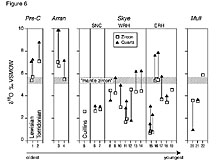Oxygen Isotope Ratios of Zircon: Magma Genesis of Low d18O Granites from the British Tertiary Igneous Province, Western Scotland
Monani, Salma and Valley, John W. (2001) Oxygen isotope ratios of zircon: magma genesis of low d18O granites from the British Tertiary Igneous Province, Western Scotland. Earth and Planetary Science Letters, v. 184, p. 377-392
Abstract
Igneous zircons from granites of the British Tertiary Igneous Province (BTIP), in western Scotland preserve magmatic oxygen isotope ratios in spite of hydrothermal alteration and thus provide new evidence for the genesis of granites. CO2 laser and mass spectrometer based bulk (1-3 mg) oxygen isotope analyses from individual plutons show remarkable homogeneity in zircon d18O, regardless of zircon size and magnetism (average reproducibility of d18O (Zrc) in a single pluton is ± 0.2‰). In addition, ion microprobe analysis shows that individual zircons all have the same d18O and thus, bulk samples are homogeneous. Fourteen granite bodies from the Isle of Skye show extreme variability in zircon d18O values from pluton to pluton (d18O (Zrc) = 0.6‰ to 5.3‰ VSMOW). All the granites record zircon d18O values less than would be in high temperature equilibrium with ‘normal’ mantle (d18O (Zrc) ~ 5‰) except for the Beinn an Dubhaich granite. Zircons from one intrusion in the mafic Cuillins center also have low d18O (2.5‰). Similar variability is observed in d18O amongst three intrusions on the Isle of Mull (d18O (Zrc)=3.4‰ to 5.9‰). Both Mull and Skye are characterized by intense shallow paleohydrothermal systems, and the low and variable d18O values of the magmas likely result from melting or interaction with hydrothermally altered country rock. Analysis of granites on the Isle of Arran, where the percentage of low d18O country rocks is much less, yields higher d18O (Zrc) of 6.8‰ and 5.4‰.
Published trace element and radiogenic isotope data for BTIP mafic and felsic rocks have supported the hypothesis that the granites are formed primarily by differentiation from the mantle with magmas experiencing minimal crustal input [1]. However, conservative estimates based on oxygen isotope compositions suggest that some of the BTIP granites can only be formed by normal magmas (d18O (WR) ~ 6‰) if they assimilated significant amounts of hydrothermally altered crustal material. Some granites require up to 40% bulk crustal input and are better explained as the result of wall rock melting by an adjacent mafic pluton. Whereas Pb and Sr suggest a general trend towards increasing input of shallow crust for the younger granites [1], the correlation between age and d18O is less apparent suggesting that Pb and Sr isotopic compositions are decoupled from oxygen isotopes. This would be expected of melted country rock that was hydrothermally altered in oxygen isotope ratios, but not in Pb and Sr isotope ratios
.

